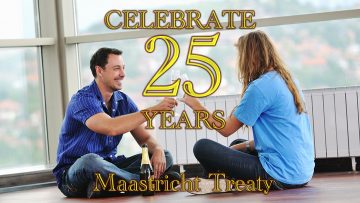Twenty-five years ago today, the Maastricht Treaty came into force. It was another step in expressing the desires of many people in Europe to bring peace and stability to the continent. It was the inspiration of European leaders after the Second World War; indeed Churchill described the vision as a ‘sort of United States of Europe’.
It started with the European Coal and Steel Community (1957) which developed into the European Economic Community (1967) and then on 1st November 1993 the European Union.
The European Coal and Steel Community was proposed by the French foreign minister Robert Schumann in May 1950 as a way to prevent further war between France and Germany. His aim was to ‘make war not only unthinkable but materially impossible’. By creating a common market for coal and steel it would reduce competition for natural resources.
The EU is not perfect. It still has a long way to go: but for the 512 million people living in the community it has brought peace and stability based on four inextricably interlinked freedoms: of movement, capital, goods and services. The logic is that people who trade together and whose economic interests are closely integrated don’t go to war against each other.
Freedom of movement allows not only the workforce to move to fulfil the needs of labour around the whole EU but also people to interact and build relationships; not relationships based on a vacation in another country but relationships based on living in each others’ countries, enjoying and celebrating the diversity we call Europe.
This vision, of a European Community providing peace and stability for its citizens, is under challenge today. Instead of community we see competition; instead of stability we see conflict and friction. Certainly some of this arises because of external factors such as terrorism and mass immigration from outside the EU. Yet it is also the result of internal factors linked to the very success of the European Union. People have become so used to peace that they no longer take seriously the possibility that we could face war on this continent and so are prepared to challenge each other.
From 1993 to 2009 the European Union was based upon three pillars – by which we mean three fundamental policy mechanisms that provided the foundation: European Communities, the Common Foreign and Security Policy and the Police and Judicial Co-operation in Criminal Matters. What this meant in practice was that the EU had a common community based on the existing EEC, it looked outward with a common foreign policy and it controlled stability with a common judicial policy. Like all treaties and international agreements it took a long time to create and contained far too many words!
In 2007 the Lisbon Treaty was signed and simplified things by amending the Maastricht Treaty, which then became know as the Treaty of the European Union or TEU.
